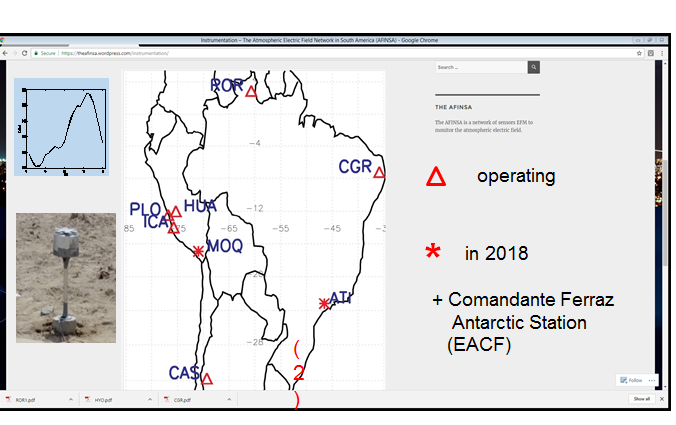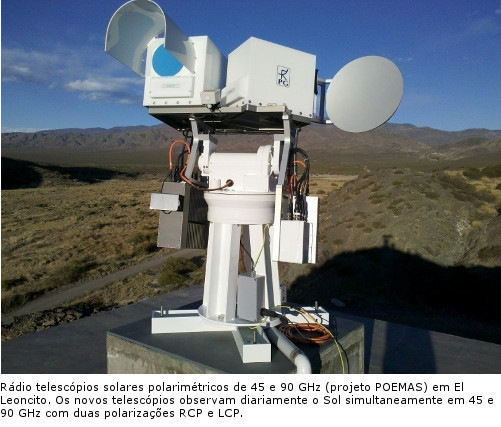Ionosphere
The ionosonde is radar that emits vertically signals in the 1 to 20 MHz frequency range, which are reflected in the ionosphere. The analysis of the signals of different frequencies transmitted and received by the system gives the vertical electron density profile. The ionosonde we operate at Brazilian Antarctic Station EACF is a ‘Canadian Advanced Digital Ionosonde’ (CADI). It operates simultaneously in two distinct modes, the first one transmits six frequencies (between 3 and 8 MHz) at each 200 seconds, and the second one transmits 80 frequencies at each 300 seconds (scanning from 1 to 20 MHz in a logaritmic scale) [Macdougall et al. 1995]. The CADI operation to at EACF started on 2009.

The main objectives of the continuous monitoring of the Global Atmospheric Electric Circuit (GAEC) are: (i) obtaining Carnegie curves and evolution in function of the season, the solar activity cycle, the presence of solar and geomagnetic disturbances; (ii) relationship with seismic activity on the Pacific coast of Peru.
The AFINSA network (Atmospheric Electric Field Network in South America) is composed of 8 sensors installed in Brazil, Argentina and Peru. Therefore, continuous measurements of the atmospheric electric field are recorded at various locations in South America. The already existing locations are: CAS (2 sensors named CAS and SAV at El Leoncito, San Juan, Argentina), PLO (1 sensor Punta Lobos, Lima, Peru), ICA (1 sensor Ica, Peru), HYO (1 sensor Huancayo, Peru), CGR (1 sensor Paraiba, Brazil), ROR (1 sensor Roraima, Brazil), and MACK (1 sensor São Paulo, Brazil). are shown as triangles in the figure. New stations (stars) are planned for beginning of operation in 2017.
Each sensor consists of a commercially manufactured (Boltek Corporation EFM100-1000120-050205) electric field mill (EFM). The minimum overall sensitivity range is ±20 kV/m and can be improved up to 40 kV/m. The response time of each sensor is 0.1 s. The basic principle of operation of the EFM stands on the fundamental laws of electromagnetism. When a conducting plate is exposed to an electric field, a charge is induced proportional to the electric field intensity and the area of the plate. The EFM produces alternate electrical fields by using an array of electrodes and rotor driven by motor.
The network is operated by CRAAM (Brazil) in collaboration with other institutions: CASLEO(Argentina), ICATE (Argentina), CONIDA (Peru). One of our first task will be to provide AFINSA data access in the form of monthly means of the fair-weather AEF.
Riometers are systems that detect the cosmic noise in the 20 and 30 MHz frequency range, which strongest source is the galactic center. The radiation at this frequency range could be absorbed while crossing the ionosphere when its condition is disturbed by the increase of radiation due solar explosions or by the impact of energetic particles. Thus, riometer can be used to monitor the ionospheric conditions. The riometer observations at EACF started on 2009, and at ROI on 2008.
At EACF we have two receivers of double frequency. One is a Javad system also used for geodesy, which for our ionospheric studies of total electron content (TEC) we use the Rinex files obtained from the raw acquired data. The other receiver is a Novatel (4004B) system specially developed for ionospheric studies, which gives TEC and scintillation.
At ROI there is a Novatel receiver; and at CRAAM there are two receivers, one Novatel and one Septentrio.
At EACF the GNSS receiver started to operate on 2004, at ROI on 2010 and at CRAAM on 2016.
The SAVNET network (South America VLF Network)
The South America VLF Network (SAVNET) uses the properties of VLF wave propagation over long distances between a transmitter (TX) and a receiver (RX) in the Earth-Ionosphere Waveguide (EIW).
Financial support
Most of the SAVNET project was funded by the Foundation for Research Support of the State of São Paulo (FAPESP). With additional funding provided by the National Research Council (CNPq), National Center for Scientific Research (CNRS-France) and Mackpesquisa.
Development Status
The tests were performed at the Observatório de Itapetinga (ROI) from May 2006 and were completed in November 2007. During this period, the design and characteristics of the VLF sensors were studied, optimized and constructed. Preamplifiers have also been developed, built and tested in ROI. The base receiver model has been observing several TXs since December 2006.
This initial SAVNET base (ATI) is near Atibaia, Brazil, S 23 degrees 11'W 46 degrees. 36'.
The remaining installation procedures were performed as follows:
- 2007, 01-08 of April - Installation in Ponta Lobos (PLO) CONIDA base in Peru: S 12 deg 30' - W 76 deg. 48';
- 2007, April 21 - May 2 - Installation in São Martinho da Serra (SMS) in Brazil: S 29 deg. 43' - W 53 deg. 43';
- 2007, 05 - 12 June - Installation in Piura (PIU) in Peru: S 05 deg. 12' - W 80 deg. 38';
- 2007, 20 - 26 May - Installation in Palmas (PAL) in Brazil: S 10 deg. 10' - W 49 deg. 20';
- 2007, July 26 - August 04 - Installation in CASLEO (CAS) in Argentina: S 31 deg. 32' - W 68 deg. 31';
- 2007, December - Installation at Anarctic Station Comandante Ferraz (EAC) in Brazil: S 62 deg. 05' - W 58 deg. 24';
- 2009, April - Installation in Ica (Ica) in Peru: S 31 deg. 32' - W 68 deg. 31';
- 2011, june, Installation of SAVNET-like type receivers in México;
- 2017, Update and reformulation of the SAVNET Network.
Savnet Project Instruments
Each receiver of the SAVNET base consists of two directional loop antennas (3m x 3m) and a vertical isotropic antenna (6m). The sensor signals are amplified and transported to an audio A / D card. The wave characteristics are then provided by SoftPAL: Software (Phase and Amplitude Logger Software)
Now SAVNET is composed by nine (9) receiving bases, scattered throughout the continent of South America.
- Atibaia (ATI), Brasil - S 23 graus 11'- W 46 graus. 36'
- Ponta Lobos (PLO), Peru - S 12 deg 30' - W 76 deg. 48';
- São Martinho da Serra (SMS), Brasil - S 29 deg. 43' - W 53 deg. 43';
- Piura (PIU), Peru - S 05 deg. 12' - W 80 deg. 38';
- Palmas (PAL), Brasil - S 10 deg. 10' - W 49 deg. 20';
- CASLEO (CAS), Argentina - S 31 deg. 32' - W 68 deg. 31';
- Estação Antártica Comandante Ferraz (EAC), Brasil - S 62 deg. 05' - W 58 deg. 24';
- Ica (ICA), Peru - S 14 deg. 01' - W 75 deg
- Mexico, UNAM, N 19 deg. 19’ – W 98 deg. 49’
The VLF soundings at EACF and ROI use an Atmospheric Weather Electromagnetic System for Observation Modeling and Education (AWESOME) system. It detects with high time resolution (20 ms) the VLF signals in the 1 to 50 kHz frequency range, as well as fixed frequency variations of phase and amplitude (NPM, NAA, NLM, NLK, NAU, NWC e HWV). The operations started on 2007 at EACF and ROI.
Solar
7GHz
The system consists of a 1.5 m antenna and two receivers that detect the circularly polarized radio emission of the Sun at 7 GHz. It has a sensitivity of 0.5 solar flux units, which is about ten times better than the actual other radio solar patrol telescopes. The system monitors the Sun continuously, and since 2017 is operated at CRAAM.

CARPET is a detector of charged particles (electrons, positrons, protons, muons) based on Geiger-Muller tube type sensors. It has been operated since 2006 at CASLEO, San Juan, Argentina.
Study of the modulation of the cosmic ray flux recorded by the CARPET detector on different time scales. The focus is the long-term variations associated with the solar activity cycle, transients related to solar and geomagnetic events and short duration (minutes to hours) occurring during periods of rain and / or changes in the atmospheric electric field.
This project is funded mostly by the Foundation for Research and Support of the State of São Paulo (FAPESP), the National Council for Scientific and Technological Development (CNPq) and the Mackenzie Research Fund (Mackpesquisa).
Collaborators of this project are the Lebedev Physical Institute (LPI) and the Astronomical Complex El Leoncito (CASLEO).

![Universidade Presbiteriana Mackenzie [Universidade Presbiteriana Mackenzie]](/fileadmin/CONFIGURACOES/DEFAULT_21/Resources/Public/Template/img/logo/universidade_mack_v2.svg)
